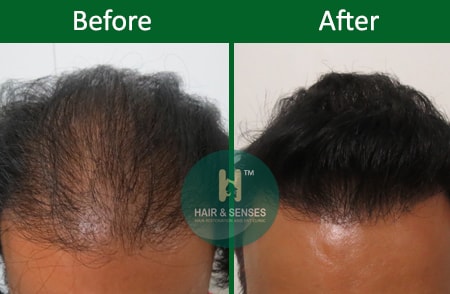Hair transplants, if not performed with surgical precision can go horribly wrong. It can leave a lasting impact on the person’s quality of life. The reason that some hair transplant surgeries go wrong is the use of outdated methods like plug procedures, mini-grafts, or scalp reductions. Besides this, poor techniques and bad planning can also result in bad hair transplants. This is where Repair Hair Transplant comes into play.
A badly done hair transplant in addition to the appearance also affects the psychology of the patient in an adverse way. At Hair & Senses, Dr. Sangay has been performing quite a number of cases of revision and repair hair transplants to provide better results and hence enhance the overall appearance of the patient.
A repair hair transplant has many challenges including the psychological aspect also. It is very important to do a detailed assessment and educate the patient about how will it be done, including the requirement of more than one procedure.
Common problems encountered are, the use of pluggy grafts, wrongly placed and wrongly designed hairlines, Placement of hair in an inappropriate direction, depletion of donor grafts, and wide donor scar. There may be scarring issues in the recipient as well as donor area. These problems give rise to cosmetically unacceptable results.
The use of large or plug-like grafts produces very unnatural-looking results. A common thing that we see at our center is trying to cover a large area of baldness with very limited donors and spreading follicles over a large area. This gives the result as good as nothing has been done. Another common mistake is not giving an age-appropriate hairline and rather going for a low or adolescent hairline. Other hairline problems include straight hairline with no proper temporal angles and lack of symmetry. When considering the direction of natural hair, the hairs exit the scalp at an angle and this angle is very acute in the temporal region. One has to mimic this natural angulation, otherwise, if the follicles are placed at a right angle to the scalp then it gives a very unnatural look to the hairs.
The donor area problem which is of concern is a wide scar. This is commonly due to excessive tension while closing the donor wound. This can be managed by grafting the hairs into the donor scar using the FUE technique. Using a FUE hair transplant, one can harvest the grafts either from the scalp or from the body.
One of the major limitations for future hair transplant sessions or for revision procedures is the depletion of the donor follicles. This can happen due to poor or over-harvesting of the grafts or harvesting large grafts. It can also happen when proper attention is not given to the progressive nature of hair loss, especially in younger age group patients, and those going for aggressive hair transplants rather than conservative procedures in these patients. One can make out when the result of the transplant is inappropriately thin and with gaps for the number of grafts used.

There are various techniques for hair transplant repair.
Camouflage
The most basic technique of hair transplant restoration is the camouflage technique. In this procedure, improper or unsightly grafts will be replaced by small follicular units or micro-grafts that would give it a more natural look. The camouflage technique can be done as a stand-alone technique or in conjunction with other methods. However, if the graft, which needs to be camouflaged is centrally located or has hair pointing in the wrong direction then the camouflage method is not enough. Camouflage also cannot help restore hair that has been transplanted too low on the forehead. This is one of the alternate techniques for repairing hair transplant
Graft Excision
In graft excision, the abnormal grafts are first carefully removed and then distributed into each follicular unit after which it is re-implanted in the proper location. Besides this, another great advantage of this technique is that when the grafts are removed, the underlying scarred tissue is also removed, hence greatly improving the overall appearance
However, if the grafts are very small and many in number, but in the wrong location or direction i.e. too low on the forehead, it's best to avoid graft excision. In such a case, laser hair removal may be the best technique.
Combined Repair
In the combined repair method, large grafts or plugs are first removed, dissected, and then re-planted, which is then followed by additional camouflage procedures using hair obtained from the donor area.
However, if the large grafts are equally distributed and are in the proper direction or location, additional follicular units are simply placed around these grafts to give a more natural appeal. In case the large grafts need to be removed, the process of removal and re-plantation might take a longer time. Once the larger grafts are dissected, additional hair is taken from the donor area for camouflage. This process of using hair excision in conjunction with camouflage is known as combined repair.
Other techniques for repairing hair transplants that are also used are LASER removal and Scalp micro pigmentation.
So if you are a victim of a hair transplant gone wrong, then look no further. Hair & Senses is here for your rescue! Equipped with state-of-the-art technology and hair transplant experts with over 10 years of experience, we at Hair & Senses will restore your previous hair transplant and your confidence. So, get the best hair repair transplant in Delhi, India now.
Source - https://hairnsenses.co.in/Repair-Hair-Transplant.php
No comments:
Post a Comment